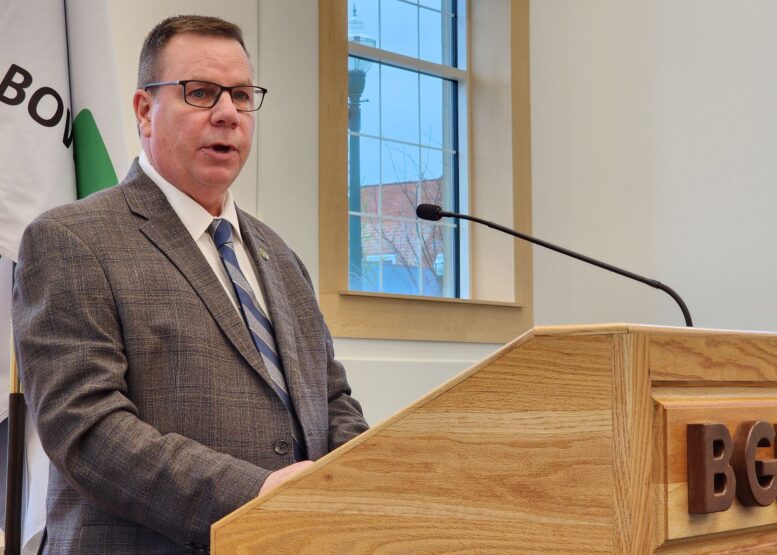By JAN McLAUGHLIN
BG Independent News
For the first time, Bowling Green’s mayor didn’t have to take the show on the road for the annual State of the City address Thursday morning.
Instead, Mayor Mike Aspacher walked down the flight of stairs from his office and spoke to citizens and staff in the ample council chambers of the new City Administration Building.
Aspacher had a list brimming with city accomplishments, followed by an equally packed list of future projects in the works.
Before beginning his speech, Aspacher confided that delivering the “State of the City” address is easy since Bowling Green has such a great story to tell.
But even a second term mayor needs a little help at times.
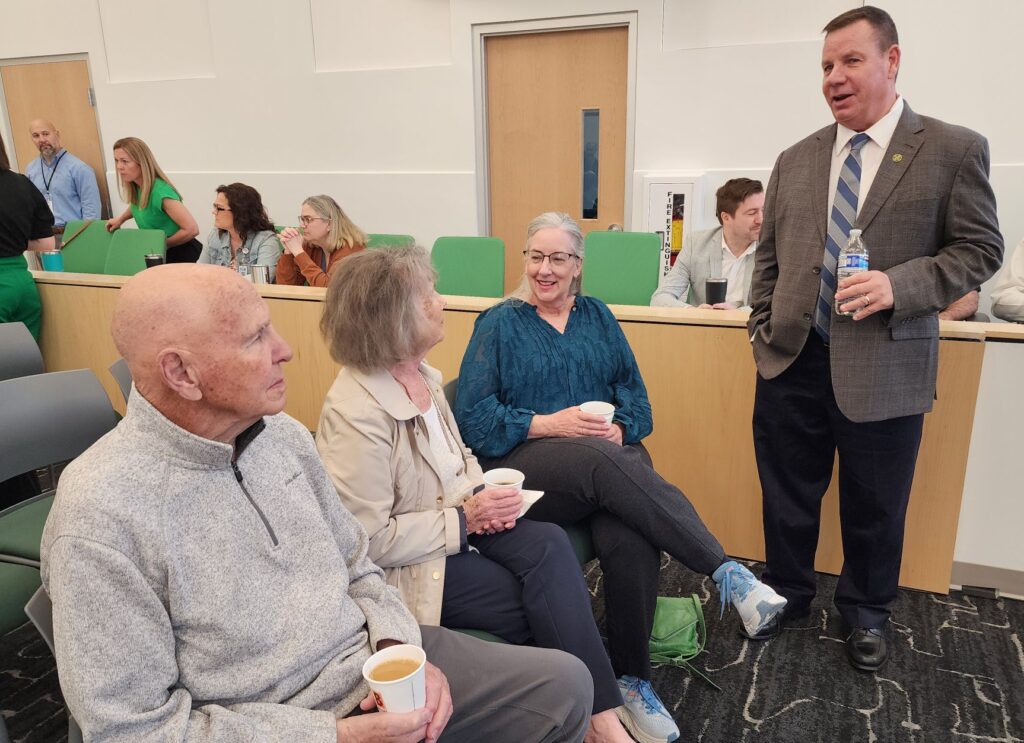
Prior to previous speeches, it was Aspacher’s mom, Sandy, who was doing last minute adjustments to the mayor’s tie. This morning it was his dad, Tony, who suggested some tweaks to the mayor’s collar.
“I never expected him to correct me,” the mayor said with a smile as he approached the podium.
“As I start my second term of office, I want to thank the community for its continuing support,” Aspacher said beginning his speech. “I am both grateful and humbled to serve as mayor of my hometown and be part of the collective effort to govern our community.”
Acknowledging the progress made in 2023, the mayor also noted that some seeds were planted and investments made that will bear fruit in the future.
The new city building is emblematic of Bowling Green’s upward trajectory – blending the past with the needs of today. The proud heritage can be seen elsewhere in the city – with historic signs to be erected soon to celebrate and share the community’s past.
“With that past as our foundation, we also recognize that a modern city needs to evolve and embrace new opportunities. The past cannot be a weight that holds us down – it is a base on which to build,” Aspacher said. “And today we build.”
This focus on building will be seen soon with the building of a new high school, with strong employment and growth in the industrial community, with increasing enrollment at BGSU, and with investments in future commercial and residential areas of the city, he said.
“Fulfilling these opportunities and aspirations requires careful planning and continuing awareness of maintaining our core assets and managing growth in a responsible manner,” the mayor said.
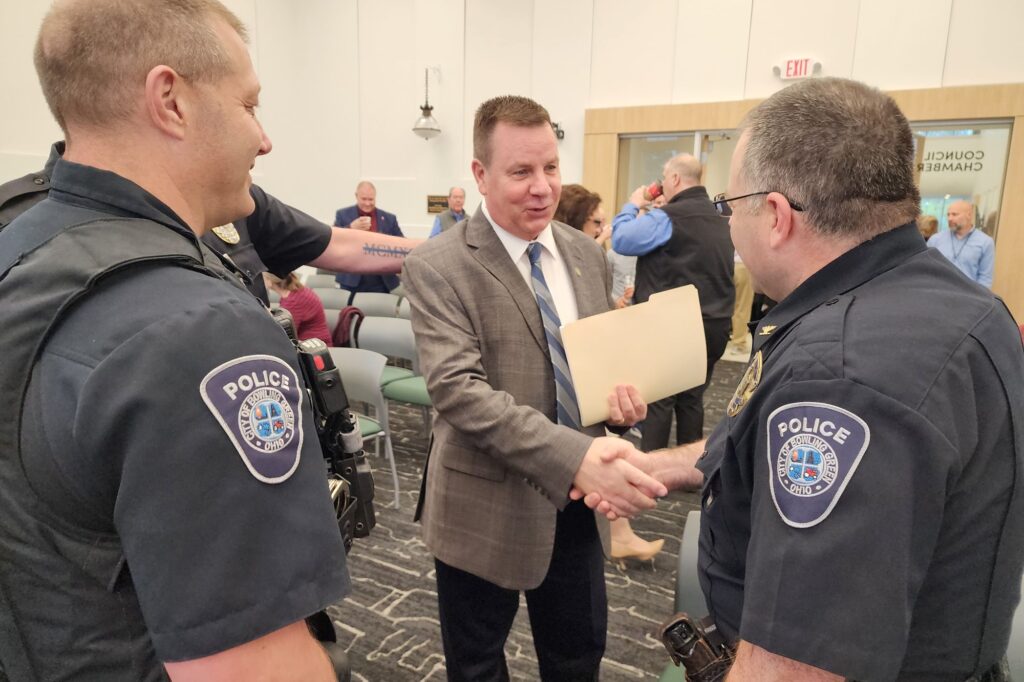
Aspacher made sure to spread the credit among the more than 300 employees who provide services that support the community.
“Consider the electricity that runs to homes and businesses, the infrastructure to clean, treat, and move drinking water and wastewater, the many components needed to support travel throughout the community, the parks where the community recreates and embraces nature, and the professional police and fire safety services,” he said.
The mayor also talked about the staff working in the new city building.
“This is the place where bills are processed, permits are issued, plans are engineered, citizen services are administered, fiscal accountability is managed, employees are hired and supported, communications are transmitted, plans are reviewed, housing assistance is processed, technology is deployed, and laws are implemented. We do a lot of things here, don’t we,” he said with a grin.
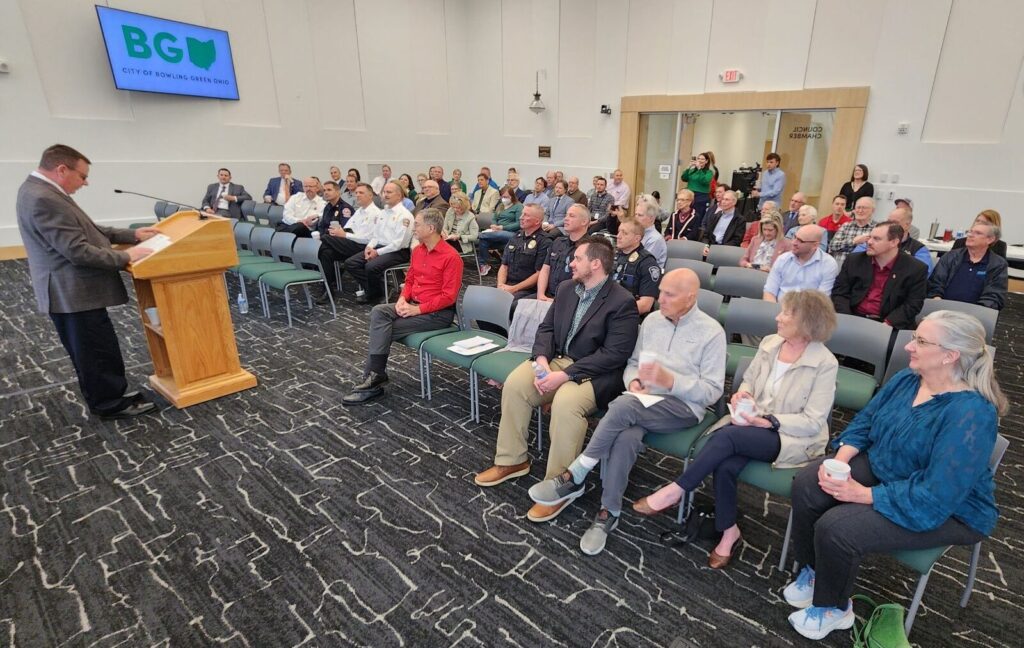
As for finances, the city is in a stable position, the mayor said. General governmental expenditures were approximately $44 million and utility fund expenditures were $107.5 million. Of this spending, approximately $33.6 million were capital purchases and another $1.7 million of ARPA special revenue funds were utilized for capital purposes. Some 2023 city capital investments included:
• $9.7 million in general utility capital
• $5 million in street repairs
• $13 million in water/sewer capital improvements
• $1.4 million in general government capital improvements
Income tax receipts were up 4.4% in 2023 as compared to 2022. This is reflective of an upward community employment environment, the mayor said.
“Bowling Green Economic Development continues to explore, innovate and apply creative approaches that ensure Bowling Green remains competitive and adaptive to today’s business needs. This includes strides to bolster the economic diversity and vitality of our community,” Aspacher said
According to Bowling Green Economic Development, 19 companies in BG created new jobs in 2023. Additionally, 27 companies reported making capital investments totaling over $92 million, and four project “wins” were reported, creating hundreds of new jobs. At the same time, the city continues to work with the economic development office to support existing businesses.
“This means, as a community, we grow with intention, recognizing that our community must maintain its identity and support existing businesses while also embracing opportunities to expand in ways that enhance and support the town,” the mayor said. “I believe both are possible.”
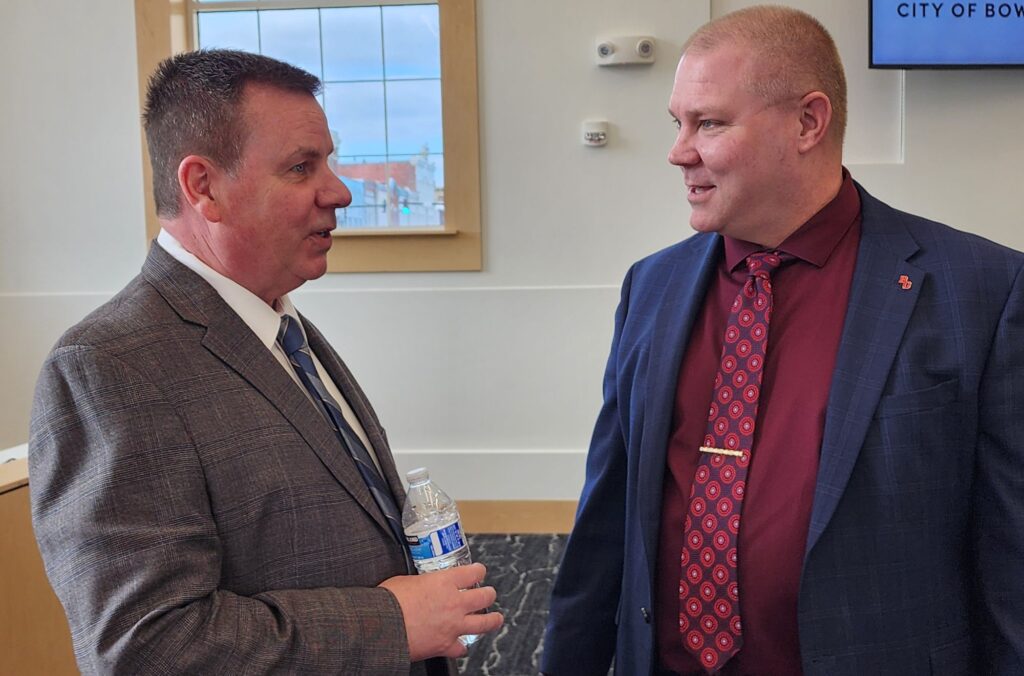
As another sign of growth, the city’s zoning regulations were updated last year, and the city issued 44 commercial permits, and 270 residential zoning permits, including 29 for new homes.
Low inventory of housing has been an ongoing challenge in the community. Last year, the city temporarily suspended certain fees for new home construction and expanded the city’s Community Reinvestment Area program to offer incentives for new home building and major remodeling.
“I’m confident we’re going to exceed that in 2024,” Aspacher said.
Efforts to improve neighborhood conditions continue, including the adoption of an exterior property maintenance code, which is designed to help maintain the health and safety of neighborhoods. Last year, the city also expanded its work with the Wood County Health Department through its exterior housing contract.
The city has a housing assistance program primarily funded by HUD’s Community Development Block Grant program. And by the end of 2024, ARPA housing funds will have provided $700,000 of assistance to over 70 homeowners. Projects included over 20 roof replacements, 30 air conditioning and furnace replacements, a dozen door and window replacements, and many others.
“These are the improvements that are having a positive effect on people’s lives,” the mayor said.
ARPA funding has also been used for:
• Residential street paving
• Grants for housing repairs
• Grants to community non-profit organizations
• Support for pool admittance fees and recreation fees for young people
• Improvements at the Carter Park Disc Golf Course
• Construction of downtown restrooms
• Walking path and security lighting at City Park
• Financial support for the construction of the inclusive playground at Carter Park
• MARCS radios (which improved communications for first responders)
Additionally, ARPA will fund future projects including side use paths connecting Crim School to Carter Park and connecting the high school to the community center.
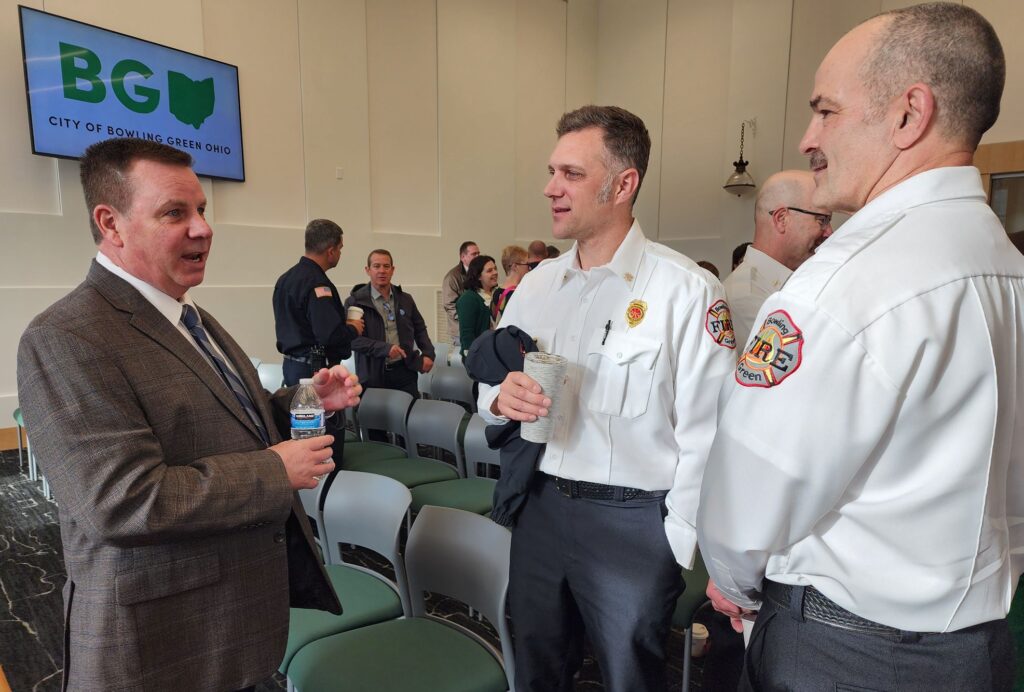
Projects that are nearing execution include a business incubator, alleyway improvements in the downtown area, pickleball courts outside the community center, and a dog park located at Ridge Park.
Last year, 15.3 miles of city streets were paved, 190 curb ramps were replaced, and the roundabout at Wooster and Campbell Hill was completed.
“The appearance of orange barrels and construction crews represent years of work and planning that took place to get the project to the final implementation stage,” Aspacher pointed out.
The city also continues to invest in its municipal utilities, earning awards for reliable electric service. And, the mayor noted, there will be no utility rate increases this year.
“Given the current economic market, I suggest this is an impressive achievement, and that this confirms that our strategic approach to be steady and responsible in the management of our municipal utilities is working,” Aspacher said.
The mayor also shared high praise for the police and fire divisions. With calls for service increasing, the police have embraced new technology including license plate cameras and drones.
The fire division also continues to get more emergency calls, and works to keep response times low. This past year, the fire division was awarded for prompt recognition, treatment, and transportation of patients suffering strokes and heart attacks. Only 27 agencies in Ohio and 324 nationwide received this award in 2023.
Projects that will come to fruition in 2024 include:
• Outdoor pickleball courts.
• All ARPA funded projects will be under contract before the end of 2024 or will become part of the city’s capital project funds in order to avoid the requirement to return the funds to the federal government. “We will work to ensure that every penny of ARPA funding allocated to our city remains in our city,” the mayor said.
• Anticipated new housing developments include both single and multi-family housing projects, and investment in current neighborhoods. “But we also can’t ignore that there are people who want to live in our community who cannot due to lack of housing availability. Maintaining existing housing assets while also managing the development of new housing options are not mutually exclusive – we can do both,” Aspacher said.
• Construction of an additional clarifier that will add capacity to the wastewater treatment plant on Dunbridge Road so it can handle a larger volume of wastewater with improved efficiency.
Some current and ongoing work to be addressed in 2024 include:
• Paving of Gypsy Lane Road, Pearl Street and Sand Ridge Road.
• Pedestrian hybrid beacon will be installed at Wooster and Maple streets, and a rapid flashing beacon will be installed at Sand Ridge and Maple streets.
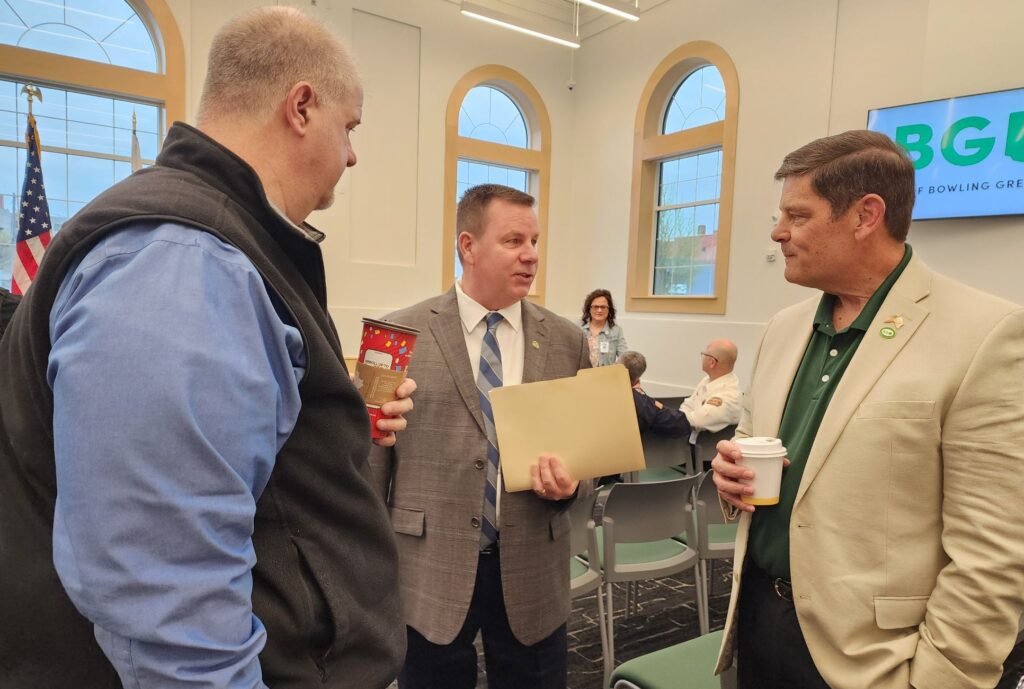
Projects in development and nearing fulfillment are:
• The recently completed Safe Routes to School Travel Plan. This will allow the city to move into the implementation phase and seek funding for projects that will improve pedestrian and bicycle safety to and from local schools.
• Downtown improvements identified by last year’s Downtown Forward planning, will include alleyway improvements, wayfinding, and public art installations.
• Plan to address needs in fire and police facilities – specifically the Court Street Fire Station and the Police Station on West Wooster Street.
• The South Main Street Improvement Project will be moving out of the planning and design phase and into the implementation phase. This project will include utility upgrades, paving, a shared use path, ADA ramp improvements, and pedestrian crossings.
The mayor also listed strategic goals of land development and expanding municipal utilities; innovation and entrepreneurship; expansion of industrial, professional, and commercial businesses; and community development efforts that enhance the quality of life in Bowling Green.
“I am confident that this positive momentum has us positioned for success well into the future. Bowling Green is a strong and vibrant community, and I am grateful and humbled to serve as the mayor of our city,” Aspacher said.

